
For the full article, read the April edition of C&T magazine
More than 6,000 raw materials are available today as ingredients for cosmetic formulators. Substances can be derived from natural sources, e.g., plants, animals and minerals, or obtained by semi-synthesis, wherein naturally occurring substances are extracted and subjected to structural modifications through precise reactions, such as certain short- or long-chain triglycerides, fatty acids and alcohols. Many synthetic molecules, either nature-identical or man-made, are prepared by combining specific chemicals.
Substances that are natural and organic are also sought for makeup applications, although not as maniacally as in skin care and cleansing products.1 However, the use of plant derivatives in cosmetic products should not be taken for granted. In fact, these types of substances are naturally unstable; some can degrade upon contact with air or sunlight. In other cases, they can heavily interfere with other ingredients in the formula. Excessive discoloration or rheological changes in recipes, oxidation reactions, bad odors, altered spreadability and adhesiveness are just some of the many drawbacks the formulator must face when dealing with plant derivatives. These problems can have an even greater impact on the performance and functionality of decorative cosmetics.
This area of technology is profoundly different from skin and hair care, both in terms of formulation as well as production and application. The visible results on skin are continuously evaluated by the consumer and their social environment. Color cosmetics are applied to provide a stable, evenly colored, continuous, elastic and plastic thin layer. They give color to extensive areas of the face, including the eye area, which is very permeable and sensitive, and several structurally complex skin appendages, such as eyelashes, eyebrows, nails and the pseudo-mucosa of the lips. Their purpose is to conceal or diminish the visibility of small skin imperfections or unwanted shading, to tidy up facial tones and to make the skin glow in particular parts of the face. Furthermore, the applied layer must resist mechanical stress and skin secretions, and be easily removable and safe. Performing the special functions of color cosmetics involves the use of ingredients that are uncommon in other types of cosmetics; alongside oils, polymers and emulsifiers is a presence of pigments, fillers and waxes. These materials and their properties will be reviewed here and in future columns — starting with pigments.
Pigments
Pigments are colored insoluble substances that are nearly chemically inert in their applied carrier, apart from ultramarine blue and manganese violet. The coloring power of pigments is high, and they have both light and temperature stability.
Pigments can be subdivided into organic (pure pigments and lakes) and inorganic when they are fully mineral in nature. The latter are less bright and show a limited range of shades in comparison with organic pigments. Inorganic pigments (white, colored and pearled) show high covering power and are stable across the entire ranges of pH, light and temperature that are relevant for cosmetics.
Moreover, they are considered safer than organic structures. They are widely used in all makeup products and are the only color developers in organic or green decorative cosmetics. They are made mainly by oxides and inorganic complex salts.
Detailed regulations in various countries govern the use of pigments in cosmetics. There are restrictions on application sites to the skin, levels of impurities and maximum amounts of pigments allowed. The key elements are their purity and interactions with the skin, with particular attention to impurities having toxic or sensitizing potential, including heavy metals such as lead, nickel, soluble chromium and mercury.2
For the full article, read the April edition of C&T magazine
References
- S. Yamamoto (2008). The roots of natural cosmetics and its modern interpretation. SOFW-Journal. 134(8) 8-12. Available at https://www.sofw.com/en/sofw-journal/archive/archive-2/372-sofw-journal-8-2008
- Rosholt, A.P., ed. (2007). International color handbook, 4th edn. Cosmetic, Toiletry and Fragrance Association (CTFA). Available at https://archive.org/details/ctfainternationa00pake











